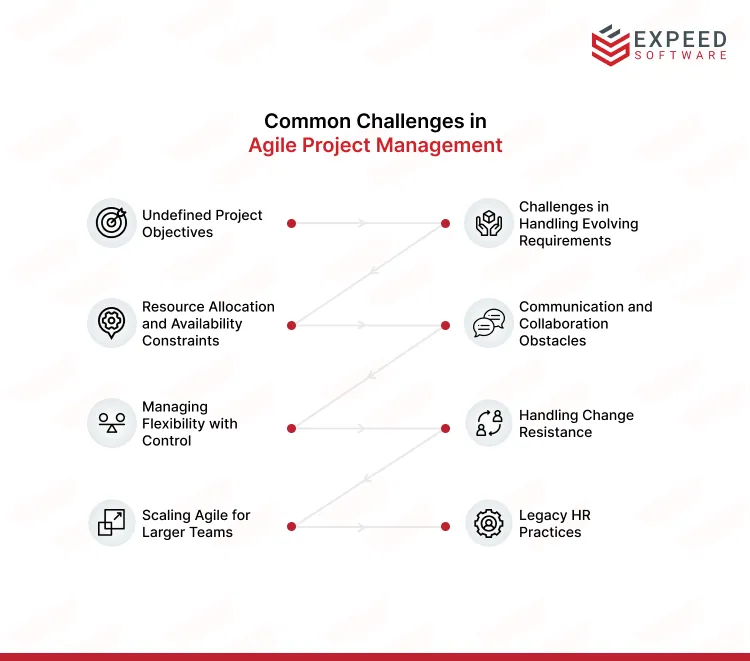In today’s dynamic world of web/mobile app development, Agile Project Management continues its sprint as a superheated methodology. The methodology depends on iterative progress, flexibility, and collaboration. The synergy between Agile Project Management and web/mobile app development ensures that teams can adapt to changes swiftly, maintain transparent communication, and constantly produce top-notch applications. However, the technology also bears numerous challenges, which can be complex if the right strategies aren’t at bay. The blog uncovers these challenges in detail, alongside the effective strategies to overcome these challenges.
Brushing Up the Term: Agile Project Management
Agile Project Management represents an iterative technique of managing projects, i.e.., web/mobile app development processes. The technology revolves around flexibility, sound collaboration, and steady improvements, depending on frequent iterations and feedback loops. The Agile team thus works on short-term cycles known as sprints, where they plan, produce, and review their work. In this way, Agile Project Management supports teams to deliver swift products, respond to changes quickly, and foster continuous adaptation.
Common Challenges in Agile Project Management

1. Undefined Project Objectives
2. Handling Evolving Requirements
3. Communication and Collaboration Obstacles
4. Resource Allocation and Availability Constraints
5. Managing Flexibility with Control
6. Handling Change Resistance
7. Scaling Agile for Larger Teams
8. Legacy HR Practices
Undefined Project Objectives
Lack of clear project objectives or goals is one of the major challenges in Agile Project Management. Web/mobile app development requirements may change over time. Hence, it could be hard to define and prioritize project goals or objectives explicitly before development. This obscurity could result in miscommunications, misalignment, and inability to yield the desired project outcomes.
To overcome this challenge, project managers need to have clear expectations from the start of the project. They should invest adequate time in defining project objectives and ensuring stakeholder alignment.
Handling Evolving Requirements
Introducing Agile Project Management methodology in Web/mobile app development projects requires you to handle changing requirements. The methodology stresses iterative development with evolving requirements as it values customer collaboration and responsiveness. However, handling these frequent shifts could be difficult as these may impact project timelines, resources, and project morale.
To tackle this challenge, project managers should set effective change management strategies to evaluate evolving requirements. Also, prioritize each requirement based on criticality and communicate them effectively with concerned teams. This helps enhance transparency and reduce disruption caused by changing requirements.
Communication and Collaboration Obstacles
Agile Project Management success depends on diverse factors. One of the essential features for success is sound communication and collaboration. However, there can be hurdles if the teams are geographically spread, work in different time zones, or have language barriers. The situation can cause delays in decision-making, and misconceptions which can impact the overall productivity of the business.
As a measure, project managers must try to foster open or transparent communication across the team. Likewise, they need to encourage regular team interactions and utilize appropriate collaboration tools. With this in practice, businesses can eradicate communication barriers and enable useful collaboration among team members.
Resource Allocation and Availability Constraints
Iterations are the backbone of Agile Project Management methodology that helps it to deliver the required results. These short iterations will require skilled and extensive resource capability to deliver the true value in a minimum time. This could raise a challenge if the resources are involved in multiple projects simultaneously. These conflicting priorities can hinder project progress and deviate you from the project goals.
To ensure adequate resource allocation and optimum resource utilization, project managers must work closely with resource managers. They should be able to manage competing demands and guarantee availability without pauses. Useful resource planning and allocation approaches help swamp these challenges and maintain the project’s velocity.
Managing Flexibility with Control
One of the most prevalent traits of Agile Project Management is its flexibility, enabling quick iterations based on shifting market dynamics. But, bringing the right harmony between flexibility and control can be tough. Excess flexibility might drive scope creep, project instability, and skipped deadlines.
Here, project managers must set a framework capable of delivering a good structure and control while not compromising innovation and flexibility. This balance is required to keep the project on track and utilize the benefits of Agile methodology.
Handling Change Resistance
Agile Project Management presents a total shift to the process and roles within traditional project management environments. This resistance to shifts or change is one of the common challenges encountered by project teams. Some team members may be reluctant to change established processes, adapt to new roles, or follow an iterative approach.
To avoid this challenge, project managers should inform team members about Agile principles and foster continuous learning. Also, they need to involve team members actively in the decision-making processes. By doing so, it helps to overcome resistance and enable a flawless transition to the Agile Project Management culture.
Scaling Agile for Larger Teams
Agile, at first, originated from small, co-located teams. Today, organizations need to scale Agile practices to bigger and more distributed teams. Scaling Agile Project Management raises additional challenges and complexities. These challenges involve coordinating multiple team efforts, maintaining proper communication and collaboration, and aligning priorities.
Project managers should look for robust scaling frameworks, like Large-Scale Scrum (LeSS) or Scaled Agile Framework (SAFe). This allows for the effective implementation of Agile practices at the enterprise level. It also boosts scalability and maximizes the benefits of Agile Project Management across businesses.
Legacy HR Practices
Conventional HR practices often conflict with Agile methodologies. These traditional approaches stress fixed roles, job definitions, and top-down management, hindering the flexibility and collaboration required for projects. HR departments might find it difficult to adapt to the dynamic nature of Agile teams, where individuals take on roles based on project requirements rather than predefined roles.
As a solution, businesses should implement Agile principles in hiring and employee growth. Focus on recruiting individuals with multiple skills and adaptability. Let team members pick roles based on their skills applicable to the project, rather than clinging to rigid job descriptions. Also, provide training in Agile practices for HR personnel to better understand and support teams.
Strategies to Alleviate the Agile Project Management Challenges
1) Undefined Project Objectives
Define Clear Goals: Collaborate with stakeholders to set clear and specific project goals. This ensures everyone understands the objectives and aligns with the project’s intent.
Prioritize and Communicate Goals: Prioritize goals by criticality and frequently communicate them to the team. Revisit and refine these goals as the project grows over time.
2) Handling Evolving Requirements
Adopt Agile Principles: Consider changing requirements as options to enhance customer value. Take the Agile mindset of flexibility and constant improvement.
Implement Change Management: Establish a structured process to assess, prioritize, and integrate changes. Transparently communicate these changes to the team and stakeholders to maintain alignment.
3) Communication and Collaboration Obstacles
Encourage Open Communication: Make an environment that facilitates open dialogue and systematic collaboration. Use effective communication tools and platforms for efficient information sharing.
Regular Stand-Up Meetings: Conduct regular stand-up meetings for team updates, collaboration, and problem-solving. This keeps teams aligned and informed.
4) Resource Allocation and Availability
Prioritize Resource Allocation: Effectively prioritize and allocate resources by working closely with Resource Managers. Make sure that critical project roles have the needed time and availability.
Optimize Resource Utilization: Constantly monitor resource usage, identify bottlenecks and balance workloads. This guarantees efficient and effective project execution.
5) Balancing Flexibility and Control
Define Project Guidelines: Set explicit project boundaries, processes, and decision-making frameworks to balance flexibility with the required control.
Empower the Team: Allow team members to make decisions within their expertise, fostering innovation while providing alignment with project goals.
6) Resistance to Change
Deliver Agile Training: Provide workshops and training sessions to orient team members with Agile principles, procedures, and practices.
Lead by Example: Execute Agile practices visibly and successfully, facilitating gradual adoption and providing help throughout the shift.
7) Scalability of Agile Practices
Adopt Scaling Frameworks: Implement frameworks like Scaled Agile Framework (SAFe) to scale Agile practices across larger projects. This helps deliver guidelines for coordination.
Promote Cross-Team Communication: Encourage communication and collaboration among teams acting on connected projects. This stimulates knowledge sharing and priority alignment.
8) Traditional HR Practices
Promote Team Building: Move focus from pre-existing roles to involving the right people in projects. This allows team participation based on expertise and confidence.
Build Relationships and Communication: Encourage voluntary involvement from team members who feel capable, enabling specified working relationships and trust within the project.
Conclusion
Agile Project Management is the most widely used technique for mobile/web application development projects. However, teams sticking to traditional techniques might find it challenging to shift from non-Agile to Agile methodology. Although approaches are necessary for project managers to raise the caliber of their output, overcoming old habits may be more challenging than you anticipate. Understanding these common challenges beforehand can help you address them correctly and thus help you implement Agile methodology more effectively. Adopting Agile SDLC for software development improved 64% of business’s ability to effectively handle changing priorities.
At Expeed Software, our team understands the unique challenges on the path of Agile Project Management and offers robust solutions to address them. Our application development services provide the expertise and tools to tackle common hurdles to changing requirements and fostering effective communication. We help you enforce strategies to enhance team collaboration, streamline processes, and ensure project success.

